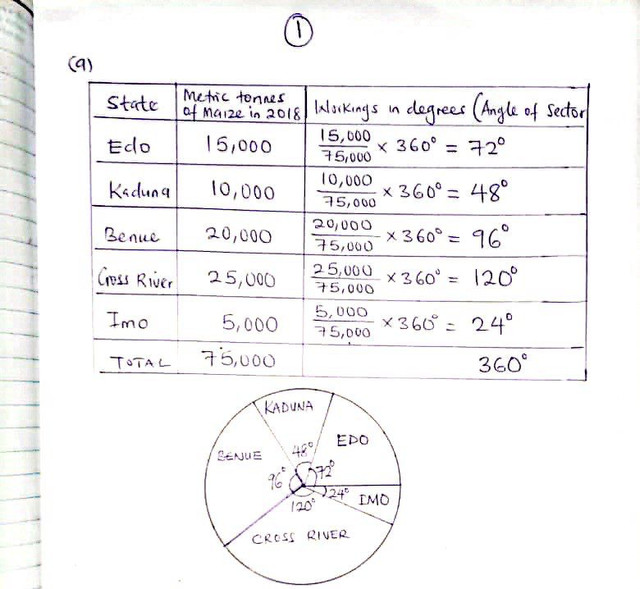
2024 NABTEB Geography Obj & Essay Questions and answers
2024 NABTEB GEOGRAPHY
01-10: BCADDDAADC
11-20: BDAADABACB
21-30: AABADADAAA
31-40: BABAADBDDB
41-50: DBCBDDBBCC
COMPLETED
*NABTEB GEOGRAPHY*
(1a)

(1b)
(PICK TWO ONLY)
(i) It provides basis for comparing variables provided.
(ii) It helps to interpret value of variables.
(iii) It shows relationship between two or more variables.
(1c)
(PICK TWO ONLY)
(i) It is difficult to compare the sizes of different segments.
(ii) It is limited to a small number of categories.
(iii) It is difficult to show hierarchical data.
(iv) Not suitable for time-series data.
(2ai) Shifting Cultivation is a practice that involves clearing a piece of land, usually by burning the vegetation, and then cultivating it for a few years. After the soil fertility declines, the farmer abandons the land and moves to a new area, allowing the abandoned land to regain its fertility.
(2aii) Transhumance is a pastoral system where herders move seasonally with their livestock between established grazing grounds. This involves migrating from the northern savanna to the southern forest areas during the dry season to find better grazing conditions. This migration helps maintain the health and productivity of the herds by ensuring access to adequate pasture and water.
(2b)
(i) Provision of raw materials: Agriculture provides raw materials such as cotton, rubber, and palm oil that are used as inputs in industrial production. These raw materials are processed and transformed into finished goods, which are then consumed by individuals or used as inputs in other industries.
(ii) Provision of market: Agriculture provides a market for industrial goods such as fertilizers, pesticides, and machinery. Farmers need these goods to produce crops and livestock, and industries produce them to meet this demand. This creates a market for industrial goods and stimulates industrial development.
(iii) Shift of factors of production: As agriculture becomes more mechanized and productive, labor and capital are released from the agricultural sector and can be shifted to the industrial sector. This leads to an increase in the labor force and capital available for industrial production, which can stimulate industrial growth.
(iv) Development of industrial sector: Agriculture contributes to the development of the industrial sector by providing raw materials, stimulating demand for industrial goods, and releasing factors of production to the industrial sector. As the industrial sector grows, it can lead to the development of new industries, creation of jobs, and increase in GDP.
(2ci)
(i) Poor Transportation Network
(ii) Lack of Storage and Processing Facilities
(iii) Use of Crude Implements
(iv) Inadequate Agricultural Education and Extension Services
(iv) Lack of Finance or Credit Facilities
(2cii)
(PICK THREE ONLY)
(i) Constructing roads and bridges to improve the transportation of agricultural products.
(ii) Establishing storage facilities like silos and warehouses and processing facilities such as mills and factories.
(iii) Introducing modern farming techniques and providing modern farm tools and equipment like tractors, plows, and irrigation machines.
(iv) Establishing agricultural training institutions and providing extension services to educate farmers on modern practices.
(v) Offering credit facilities to farmers and setting up agricultural banks to provide loans.
(3a) Urbanization is the process of people moving from rural areas to urban centers, resulting in the growth and development of cities and towns. It involves a significant increase in the proportion of a population living in urban areas, leading to changes in the social, economic, and physical characteristics of these areas.
(3b)
(PICK FOUR ONLY)
(i) Accessibility: Urban areas with good accessibility through roads, railways, and other transport networks attract people as they facilitate movement, trade, and communication.
(ii) Climate: Favorable climate conditions in urban areas can attract people, as they prefer to live in regions with comfortable weather and minimal natural disasters.
(iii) Economic Activities: The concentration of industries, businesses, and other economic activities in urban areas creates job opportunities and attracts people seeking better livelihoods.
(iv) Provision of Social Amenities: Urban areas often provide better social amenities such as healthcare, education, and recreational facilities, making them more appealing to people from rural areas.
(v) Relief: The physical landscape or relief of an area can influence urbanisation. Flat or gently sloping land is easier to build on and more suitable for urban development, making such areas more attractive for settlement and growth.
(3c)
(PICK FIVE ONLY)
(i) Environmental Pollution: Urbanisation significantly increases environmental pollution, including air pollution from industrial and vehicular sources, and water pollution from inadequate waste management. The rise in construction and population density further contributes to environmental degradation.
(ii) Traffic and Housing Congestion: Rapid urban growth causes severe traffic congestion due to the high number of vehicles and often insufficient road infrastructure. Housing congestion results from the population growth outpacing housing supply, leading to overcrowded living conditions and informal settlements.
(iii) Unemployment: Urban areas often face high unemployment rates when the influx of people surpasses the creation of new jobs. This imbalance leads to increased competition for limited positions and can result in underemployment.
(iv) High Cost of Living: The cost of living in urban areas tends to rise due to increased demand for housing, goods, and services. This leads to higher prices for essentials and can make urban living more expensive for residents.
(v) Decrease in Agricultural Land: As urban areas expand, they encroach on agricultural land, reducing the space available for farming. This decrease in farmland can impact local food production and increase reliance on food imports.
(vi) Increased Demand for Social Amenities: The growing urban population heightens demand for essential social amenities such as healthcare, education, and recreational facilities. This increased demand can strain existing services and lead to overcrowding and reduced quality.
(vii) Increased Demand for Goods and Services: Urbanisation drives up the demand for various goods and services as the population grows. This increased demand can strain supply chains, leading to potential shortages and higher prices, which affect the overall cost of living.
(5a)
Transportation is the movement of people, goods, and services from one place to another. It involves various modes such as roads, railways, waterways, airways, and pipelines.
(5b)

(5c)
(PICK FIVE ONLY)
(i) Revenue Generation to the Government: Seaports are a significant source of revenue for the government through duties, taxes, and various charges on imported and exported goods. This revenue contributes to the national GDP and is crucial for financing infrastructure and development projects.
(ii) Provision of Employment to the People: Seaports create numerous job opportunities in sectors such as cargo handling, transportation, logistics, and port management. This employment helps to reduce unemployment rates, enhance living standards, and contribute to economic stability.
(iii) Importation of Raw Materials for Industries: Seaports play a critical role in facilitating the importation of raw materials essential for industrial production. By ensuring a steady supply of these materials, seaports support industrial development and stimulate overall economic growth.
(iv) Tourist Attraction: Seaports can serve as key tourist attractions, drawing visitors who spend on local services such as hotels, restaurants, and entertainment. This not only boosts the local economy but also helps in diversifying Nigeria’s economic base beyond oil exports.
(v) Linkages Between Areas of Production and Consumption: Seaports act as crucial linkages between areas of production and consumption, enabling the efficient movement of goods and services. This connectivity promotes trade, commerce, and economic integration across different regions.
(vi) Access to Natural Resources: Seaports provide vital access to Nigeria’s natural resources, including oil, gas, and minerals. This access supports economic development by facilitating the export of these resources and driving industrial growth.
(vii) Promotion of Intensive Fishing: Seaports support the fishing industry by offering facilities for processing and exporting fish. This promotes intensive fishing practices, contributing to food security, economic activity, and providing a valuable source of protein for the population.
(6a)
(PICK FOUR ONLY)
(i) Relief and Waterfalls: The presence of relief features such as mountains and valleys creates significant elevation drops, which are crucial for hydro-electric power generation. Waterfalls provide natural sources of energy that can be harnessed for generating electricity.
(ii) Abundance of Rainfall: Consistent rainfall ensures a steady supply of water to rivers, essential for hydro-electric power generation. Nigeria’s high rainfall ensures that rivers are constantly replenished, providing a reliable water source for hydro-electric power generation.
(iii) Rivers with High Volume of Water: Major rivers like the Niger and Benue provide significant and continuous water supplies needed for hydro-electric power development. These rivers have high volumes of water necessary for generating electricity on a large scale.
(iv) Steep Gradients : Present of steep gradients facilitate the rapid movement of water, essential for turning turbines quickly and generating electricity efficiently. The steep gradients in Nigeria’s terrain create a significant drop in elevation, necessary for hydro-electric power generation.
(v) Nature of Bedrocks: Suitable bedrock provides a good foundation for constructing hydro-electric power facilities and prevents water from percolating away. The nature of bedrocks in Nigeria is suitable for constructing dams and hydro-electric power plants, making it an ideal location for hydro-electric power generation.
(6b)
(i) Provides a reliable water source for irrigation, enhancing agricultural productivity.
(ii) Creates jobs in construction, operation, and maintenance of hydro-electric projects.
(iii) Supplies clean, reliable electricity for homes and industries.
(iv) Generates revenue through electricity sales, contributing to economic development.
(6c)
(PICK FOUR ONLY)
(i) Seasonal fluctuations in river volume can significantly affect the consistency of water supply for hydro-electric power generation, making it challenging to maintain steady electricity output.
(ii) Sandspits and bars can obstruct water flow, which severely impacts the efficiency of hydro-electric power plants, requiring extensive maintenance to clear these obstructions.
(iii) The development and operation of hydro-electric power plants require specialized skills and expertise, and Nigeria faces a shortage of trained professionals, leading to inefficiencies and potential operational issues.
(iv) Conflicts can arise from the uncoordinated use of river resources among various stakeholders, including the government and local communities, which can hamper the smooth development of hydro-electric power projects.
(v) The construction of dams often results in the displacement of local communities, creating significant social challenges, including the need for resettlement and compensation for affected individuals.

Leave a Reply